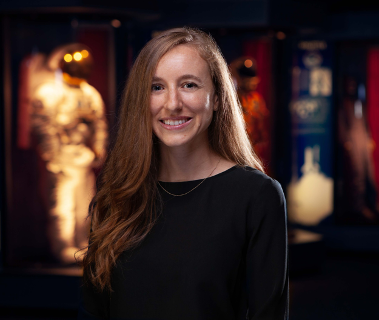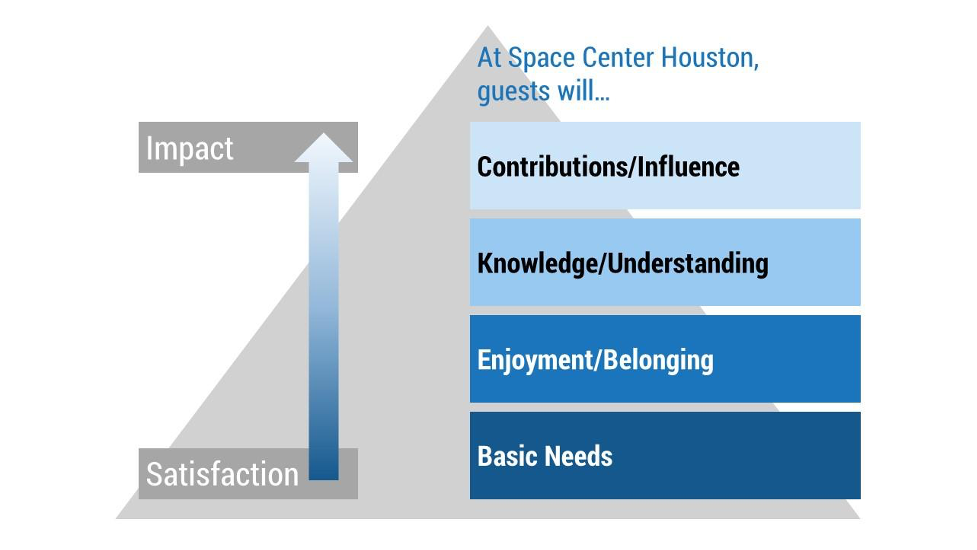
Hello! I’m Lauren Holley, the Audience and Evaluation Specialist at Space Center Houston. I work with our full organization; as our first in-house evaluator, I am shaping colleagues’ perspectives of evaluation and embedding accountability, iterative improvement, and focus on outcomes into our offerings.
Our greatest and broadest offering is our general visitor experience. With consistent guest experience feedback on visit offerings from once-siloed departments, our team needed a way to unify our vision and pinpoint adjustments. A few colleagues were familiar with the classic logic model, but I wanted to create a tool that would be easy to digest at a glance and touched on fundamental aspects of a guest’s experience, too. What resulted: a four-part Guest Needs Hierarchy that illustrates our intended goals for a typical visit to Space Center Houston.

Hot Tips
Break down the visitor experience
Staff were eager to begin measuring the impact they had on visitors, but I encouraged a focus on the full picture of the guest experience—from visitors’ basic needs and satisfaction up through the contributions to society they would (hopefully) make after engaging with our offerings. I split these into four successive layers: Basic Needs, Enjoyment/Belonging, Knowledge/Understanding, and Contributions/Influence. I like to remind our team that to “change hearts and minds,” we must first ensure our visitors are comfortable and confident in our space.
Broken down, each team can see their ownership in parts of the guest experience. Our custodial and guest services teams understand their role is crucial in meeting basic needs, while our education and exhibits teams see the importance of enjoyment as a precursor to the ah-ha moments they elicit.
Use simple, recognizable visuals to reinforce common language
To underscore the foundational needs of visitors, I borrowed from a well-known psychologist, Abraham Maslow and the Blackfoot Nation before him (see the note and Rad Resources below), whose pyramid motivational model necessitates that lower-level needs must be satisfied before progressing upward. When our team sees our pyramid visual, their understanding of the visitor experience is backed by prior knowledge of the hierarchy. With the visual shorthand, we can discuss otherwise intangible goals for our guests with reference to where they fall on the map. It’s clear that “become a member” falls under Enjoyment/ Belonging, “see the everyday value of technological advancements created for space travel” is a Knowledge/ Understanding outcome, and “collaborate to tackle difficult problems” is a visitor’s Contribution/ Influence in changing our world for the better. When we talk about our impact, we know we’re talking about upper tiers of the pyramid, beyond satisfaction.
Find your advocates
Before launching the Guest Needs Hierarchy as a tool, I workshopped a sketch with several colleagues across the organization. I gauged their reactions, incorporated their feedback, and shared more broadly with a larger cross-departmental team. In increasing focus on guest experience improvements, our Chief Operating Officer and Project Specialist, Strategic Initiatives have adopted the Guest Needs Hierarchy and reference it in all-staff briefings, board meetings, and onboarding for new staff. With their uptake and cross-departmental presence, the model is pervasive and serves as a quick reference when developing or refining aspects of the typical visitor experience.
Rad Resources
What goes around, comes around! In adapting an existing model, I perpetuated a history of the pyramidal model being taken, altered, and repackaged– and at times, without acknowledgement of its origin. Many thanks to our Arts, Museums and Culture TIG for alerting me to this!
- Maslow’s Hierarchy of Needs and Blackfoot (Siksika) Nation Beliefs: If this is new to you, please read the excellent summary by Barbara Bray of how the model is rooted in Blackfoot beliefs and Maslow’s version whitewashes and erases this origin.
- Before Maslow’s Hierarchy: The Whitewashing of Indigenous Knowledge: Shane Safir also offers details on how the model distorts the Blackfoot perspective.
The American Evaluation Association is hosting Arts, Culture, and Museums (ACM) TIG Week. The contributions all week come from ACM TIG members. Do you have questions, concerns, kudos, or content to extend this AEA365 contribution? Please add them in the comments section for this post on the AEA365 webpage so that we may enrich our community of practice. Would you like to submit an AEA365 Tip? Please send a note of interest to AEA365@eval.org. AEA365 is sponsored by the American Evaluation Association and provides a Tip-a-Day by and for evaluators. The views and opinions expressed on the AEA365 blog are solely those of the original authors and other contributors. These views and opinions do not necessarily represent those of the American Evaluation Association, and/or any/all contributors to this site.

Hi Lauren,
I am currently working on my masters of education through Queen’s University, in Canada. Currently, I am taking a course of program evaluation and have spent the last 6 weeks or so learning about systematic evaluative inquiry in support of the data-informed program decision-making. We have been examining the multiple purposes of program evaluation applying the principles, methods and logic inherent in the needs of targeted program personnel and decision makers. Needless to say we have been learning a lot about what goes into program evaluations, including needs assessments. I was initially drawn to your article and model because I believe it would work well in an education context when it comes to the professional development of teachers, the implementation of new programs and system wide initiatives. Teachers often work in silos and often don’t get to see or the opportunity to fully understand how programs or initiatives impact the whole. Your model would allow all teachers the opportunity to see the intended program goals, understand the vision of the initiative or program clearly and see how their role will impact the output (ownership in the process). I think at times, system level leadership forgets how important these pieces are for educators to see and understand. Your model is simplistic in nature but packs a lot of punch in its visual representation – easy to take in; easy to see where and who owns what impacts/piece. This would help contribute to educator buy-in, the understanding of relevance and hopefully the “why” behind the program/initiative.
I really liked how you highlighted the importance of breaking down the experience to allow all members of the team to see their impact and understand the importance of their role when it comes to meeting needs or program goals. I also found your point about using simple visuals to reinforce common language essential to keep everyone on the ‘same page’ and the understanding clear. From this model what would your next steps be to further enhance the guest experience?
Thank you!
Hi Dani!
My apologies on the belated reply– I only just now saw your thoughtful comment. Thanks for the kind words, and please do feel free to use this structure within the education context if you see it serving to ground teacher experience in the larger context. I certainly appreciate that utility in the simplicity, and I do find that others are able to recall the model by memory once they’ve seen it a few times.
In terms of next steps: we’ve been finding solutions for pain points in the Basic Needs and Enjoyment levels of the guest experience (we generally rate pretty well on feelings of Belonging) while also clarifying our messaging on the upper tiers of the pyramid. It’s really teed us up for conversations about types of outcomes, too, and what’s easily measurable within our context and what might be a longer-range outcome we contribute toward, but won’t see within our walls or the context of one museum visit. I see the organization really starting with the guest’s perspective as we launch new initiatives, and iterating with our existing offerings based on their feedback. Truly, an evaluator’s dream!
I’d love to hear how it went if you tried it out in the formal education context.